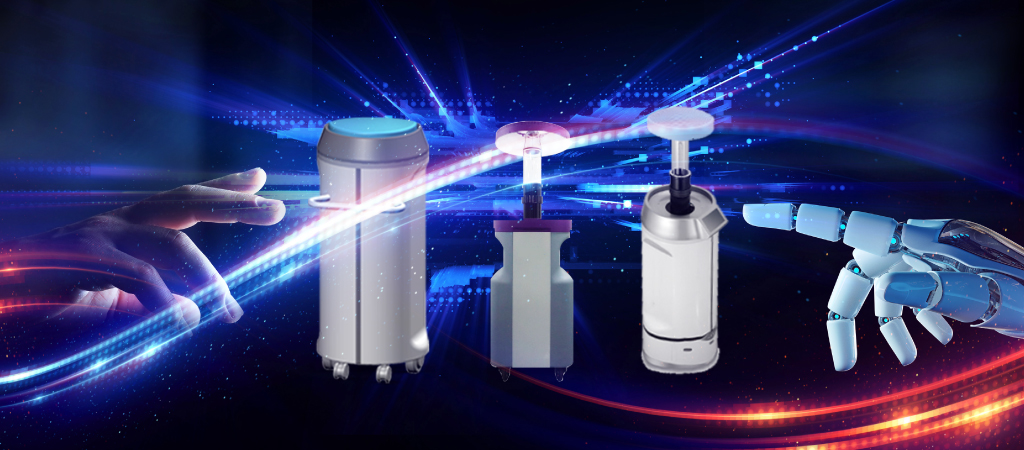Benefits of Disinfection Robotics
Every disaster is distinctive, but the experience of utilizing robots for the COVID-19 pandemic imparts an opportunity to decisively learn some lessons documented over the last 20 years. One important lesson during a disaster is that, robots used for disinfection do not replace people. They either accomplish tasks that a person could not perform safely or undertake tasks that free up responders to handle the increased workload.
Disinfection Robots are essential for performing regular disinfection in closed areas such as public transport facilities, parking areas, industrial loading, and unloading docks, as well as hospitals or other supposedly contaminated zones.
As an alternative to manual disinfection, which needs workforce mobilization and multiplies the risk of exposure to cleaning personnel, self-directed or remote-controlled Disinfection Robots could lead to cost-effective, swift, and effective disinfection.
How do Disinfection Robots work?
A disinfection and sterilization robot kills germs in the environment by decomposing their DNA structures, thus preventing and reducing the spread of viruses, bacteria and other harmful microorganisms. These UV Robots for Disinfection usually have two working modes: air circulating disinfection and sterilization, and UV disinfection and sterilization, and applies to a variety of complicated scenarios. It can move autonomously for timed, fixed-point and multi-track mobile disinfection and sterilization in large areas.
Importance of adopting UV Robots for Disinfection
Maintaining a clean and safe healthcare environment is a top priority, and while significant progress has been made in sanitization methods, major improvements must still be made. Current manual cleaning techniques are almost helpless in fighting against bacteria, but the war is not lost. Infection-prevention technologies are giving rise to a new age of ultra-clean hospital’s & emergency-care amenities with the implementation of top-efficient UV Robots for Disinfection. But the technology is not limited strictly to hospitals and doctors’ offices. The UV Robots for Disinfection can also be used to sanitize other public areas, malls etc.
These UV Robots for Disinfection are fast and efficient and can eliminate far more bacteria than humanly possible. The ability of Disinfection Robots to move around enables them to attack shadowed areas where many harmful organisms tend to manifest in places that are often missed by sanitization teams.
Hence, it’s significant to understand how Ultraviolet (UV) kills. Ultraviolet (UV) light does not destroy microorganisms in the same manner chemicals as chlorine does. The light damages DNA inside the cells of an organism, eventually deactivating the function of each cell. Evidently, genetic material readily absorbs UV rays at a specific wavelength of 254 nm.
Benefits of Disinfection Robots:
a) Strong sterilization and disinfection abilities: For instance, in the mode of UV disinfection and sterilization, condensed ultraviolet beams are emitted via a disinfection robot to kill bacteria and other harmful microorganisms, with a disinfection rate of 99.99%, which effectively prevents cross-infection in high-risk areas.
b) Non-staff operation: In compliance to the preset route and time requirements, Disinfection Robots feature independent operation and realizes scheduled, fixed-point and multi-track mobile disinfection and sterilization in a large space. It reduces the investment in human resources and helps promote the working efficiency and quality.
c) Independent charging: Disinfection Robots are skillful when it comes to independent & automatic charging, constant operation & low-power timely warning, thus efficiently ensuring the survival of this movable device.
d) Large working space: By using Disinfection Robots, a large space can be fully covered in disinfection and sterilization utilizing the chassis for autonomous movement.
e) Provides staff safety: The technical staff does not expose itself to prolonged exposure of highly concentrated chemicals and is able to work in an entirely safe and risk-free environment by using Disinfection Robots.
Hence for further prevention of any diseases, contactless UV robot-controlled surface disinfection is being utilized at present because COVID-19 disperses not only from individual-to-individual via close-contact respiratory droplet transfer but also through contaminated surfaces.
Sunartek UV Robots for Disinfection
The Sunartek UV Robots for Disinfection is designed to prevent the Virus. It is equipped with cutting edge technology including Pulsed UV Light which can kill 99.9% pathogens in 5 minutes and less than 5m operation range.
There are 3 different types of Sunartek UV Robots for Disinfection which comprise of essential features as mentioned below:
Key Features:
• Manual operation – with cable/ comprises of a battery
• Easy movement and maintenance
• Without pre-heat and easy control
• Automatic obstacle avoidance
• Smart lamp system using reflectors and movement to focus UV light towards “high-touch” surfaces.
• Wireless remote control
• Open-use, environmental protection, no chemical residue
• 5-15 minutes treatment time, fast as little as 5 minutes.
• Pulsed xenon lamp with high energy, safety and high efficiency
• Disinfects 15 rooms after fully charged
These Sunartek UVD Robots can be effectively used in several scenarios such as Public areas, Hospitals, Railways, Hotels, Airports, Malls, Offices etc.
Advantages of Sunartek Disinfection Robots:
• More than 80% decrease in infection rates
• 20 times more effective than manual cleaning with chemicals
• Takes just 5 minutes for the total treatment time
• Energy-saving and environmental protection
In a nutshell, by going for Sunartek’s ‘Pulsed UV Light’ Disinfection Robots, it will surely prove to be your ultimate choice. This is because the UV light produced by Xenon light is a thousand times stronger than LED or Mercury UV light (200 – 315nm). Thus, no pathogens can resist to Pulse Strike UVC Light as it reduces most of the suffering by destroying deadly microorganisms that can cause infection.

